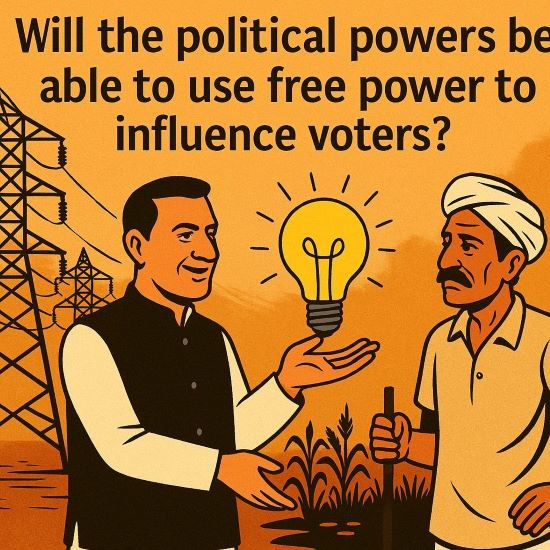 Electricity has long been India’s most potent political currency — a welfare promise that doubles as an electoral bribe. For decades, state governments have built entire political fortunes on “free power.” Now, the Centre’s new electricity-sector reform — asking states to either privatise or list their distribution companies — has jolted this entrenched populism.
Electricity has long been India’s most potent political currency — a welfare promise that doubles as an electoral bribe. For decades, state governments have built entire political fortunes on “free power.” Now, the Centre’s new electricity-sector reform — asking states to either privatise or list their distribution companies — has jolted this entrenched populism.
The move is not merely fiscal. It is structural — and necessary. India today runs on a single national grid, where power generation, transmission, and consumption are seamlessly interconnected. When one state distorts pricing or defaults on payments, the entire grid feels the shock. That is why the Centre has finally stepped into what was once a shared — and often abused — domain under the Concurrent List.
Reform — or rescue from fiscal collapse?
The Union Power Ministry’s proposal gives financially stressed states three hard options:
Sell 51 per cent stake in their discoms and hand control to private management under a public–private partnership (PPP).
This converts state-run utilities into joint ventures where private partners manage billing, collection, and infrastructure upgrades, imposing commercial discipline.
Sell 26 per cent but still cede operational control.
Even with minority equity, private players would run day-to-day operations while the state remains a passive shareholder.
If unwilling to privatise, list discoms on stock exchanges under SEBI supervision.
This would compel utilities to publish quarterly financials, disclose subsidy data, and justify their balance sheets publicly — ending the opaque populism that has long crippled state discoms.
These are not arbitrary demands. The Centre argues that politically driven free-power schemes have bankrupted utilities, distorted pricing, and endangered national grid stability. Reform, therefore, is not intrusion — it’s rescue.
Punjab: where politics meets populism
No state faces a greater reckoning than Punjab, where total electricity subsidies touch ₹20,000 crore annually — ₹10,000 crore for farmers, ₹7,000 crore for domestic consumers (300 units free), and the rest for small industries.
The Punjab State Power Corporation Limited (PSPCL) survives on delayed reimbursements. If Delhi enforces its formula, Punjab will have to either hand over PSPCL’s reins to private management or raise tariffs — both politically explosive options.

Is former Member of Punjab Public Service Commission
A farmer and keen observer of current affairs
Punjab has about 13.94 lakh agricultural tubewell connections, each pumping nearly 30 lakh litres of groundwater every week — together extracting 4,385 billion litres per week, according to PSPCL’s 2023 report. The Central Ground Water Board classifies 114 of 150 blocks as “over-exploited.” Free power, once a farmer’s right, has become an ecological and fiscal crisis.
The hidden cost to farmers
Withdrawal of free power would raise farm expenses by ₹30,000–₹50,000 a year for each cultivator. Yet the Commission for Agricultural Costs and Prices (CACP), which determines the Minimum Support Price (MSP), does not include free electricity in its cost formula.
So even if farmers begin paying for power, MSP won’t automatically rise. Without a policy correction, Punjab’s farmers would bear the entire cost shock — effectively making them poorer overnight. The fiscal logic of reform must therefore be matched by agrarian sensitivity.
⚠️ Free Power: From Relief to Ruin
Introduced in 1997, free electricity for agriculture began as a lifeline for small cultivators but has mutated into an open tap of ecological and economic waste.
Punjab’s 13.94 lakh electrified tubewells run almost eight hours a day, pumping billions of litres of water that is often not even needed. Over-irrigation of paddy, fuelled by free and unmetered electricity, has stripped the soil of nutrients, increased salinity, and produced surplus rice the nation doesn’t require. India now exports groundwater in the form of paddy while Punjab’s aquifers collapse beneath it.
The Central Ground Water Board warns that Punjab’s water table is falling by nearly a metre every year, and scientists predict parts of Malwa could turn arid within a decade. What was meant as welfare has become a slow-motion desertification policy.
Free power needs reform, not abolition — a rational redesign built on incentives and accountability:
Subsidies linked to micro-irrigation and solar pumping;
Higher tariffs for overconsumption;
Smart feeder metering and data transparency;
Crop-based disincentives for water-guzzling paddy and bonuses for pulses or oilseeds.